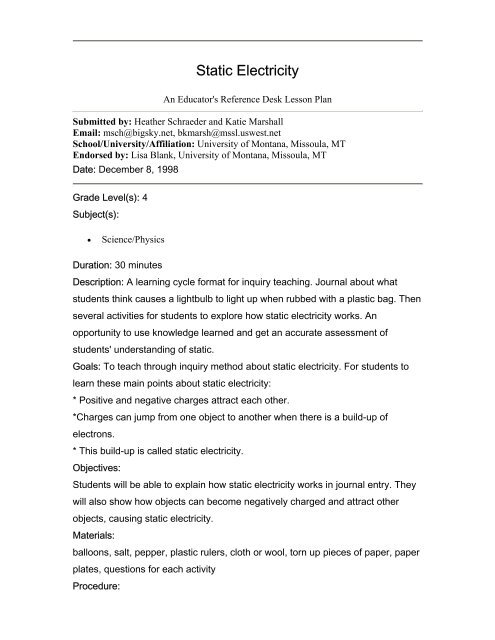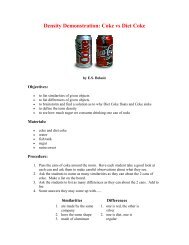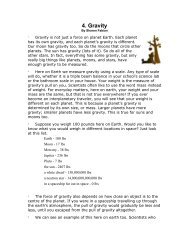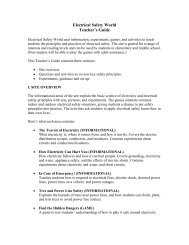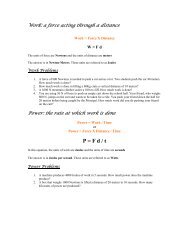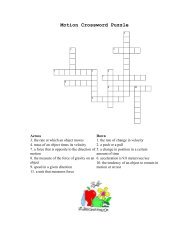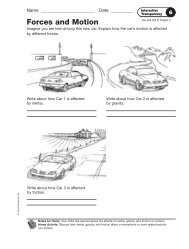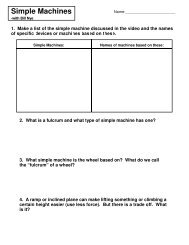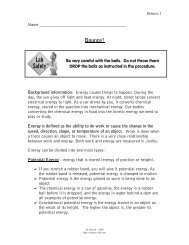Static Electricity
Static Electricity
Static Electricity
Create successful ePaper yourself
Turn your PDF publications into a flip-book with our unique Google optimized e-Paper software.
<strong>Static</strong> <strong>Electricity</strong><br />
An Educator's Reference Desk Lesson Plan<br />
Submitted by: Heather Schraeder and Katie Marshall<br />
Email: msch@bigsky.net, bkmarsh@mssl.uswest.net<br />
School/University/Affiliation: University of Montana, Missoula, MT<br />
Endorsed by: Lisa Blank, University of Montana, Missoula, MT<br />
Date: December 8, 1998<br />
Grade Level(s): 4<br />
Subject(s):<br />
• Science/Physics<br />
Duration: 30 minutes<br />
Description: A learning cycle format for inquiry teaching. Journal about what<br />
students think causes a lightbulb to light up when rubbed with a plastic bag. Then<br />
several activities for students to explore how static electricity works. An<br />
opportunity to use knowledge learned and get an accurate assessment of<br />
students' understanding of static.<br />
Goals: To teach through inquiry method about static electricity. For students to<br />
learn these main points about static electricity:<br />
* Positive and negative charges attract each other.<br />
*Charges can jump from one object to another when there is a build-up of<br />
electrons.<br />
* This build-up is called static electricity.<br />
Objectives:<br />
Students will be able to explain how static electricity works in journal entry. They<br />
will also show how objects can become negatively charged and attract other<br />
objects, causing static electricity.<br />
Materials:<br />
balloons, salt, pepper, plastic rulers, cloth or wool, torn up pieces of paper, paper<br />
plates, questions for each activity<br />
Procedure:
Concept Assessment: Hold up a lightbulb and a plastic sack and say: In your<br />
journal describe what you think will happen when I rub the plastic bag up and<br />
down the light bulb Why do you think this happens<br />
Concept Exploration: Two activities will be given to each group of students<br />
(groups of 3-4) in the class.<br />
1. This activity is with pepper and salt. A pile of pepper and salt will be on a paper<br />
plate. Take a plastic ruler and place it above the pile and see what happens. Then,<br />
rub the ruler with the cloth or wool for 5-10 seconds. Then place the ruler one<br />
inch above the pile of salt and pepper. Note the reaction.<br />
2. This activity involves the use of a balloon. Students will try to stick the balloon to<br />
the wall. Then they will rub the balloon on their head or a piece of cloth and then<br />
try to stick it to the wall. They will take note of what happens in both instances.<br />
Closure: Students will then share their results. Discuss as a class:<br />
What happened when you tried to stick the balloon to the wall without rubbing it<br />
What happened to the salt and pepper when you didn't rub the ruler<br />
Why don't you think anything happened<br />
What does rubbing the balloon and the ruler do that causes there to be a<br />
reaction<br />
What were your other findings and why do you think they occurred<br />
Introduce facts about static electricity. Discuss that electrons are negatively<br />
charged and when rubbed with other objects they build up excess electrons from<br />
the other object. Those electrons need to be released and thus, when it comes in<br />
contact with something else they are released by a zap or an attraction to<br />
positively charged protons. Draw on the board the placement of excess electrons<br />
on the outer edge of a balloon and then when you stick a balloon to the wall all<br />
the electrons jump away and the balloon is held up by the attraction of the<br />
positive and negative charges. Talk about getting shocked when you're walking<br />
around the house and what is actually happening. Have the students help you<br />
explain it by asking: So when I scuff my feet what's happening What happens<br />
when I touch someone else Why is there a shock<br />
Assessment:<br />
Concept Application: Students will be asked to find a way to use a balloon to pick<br />
up pieces of paper without touching them. All they will be given is a balloon and<br />
several torn up pieces of paper. They will have to ask for any objects they might
need. Afterwards, we would discuss why they used the method they did and why<br />
it worked. Then they'd enter in their journal what they learned about static<br />
electricity, and briefly explain what causes static electricity.


